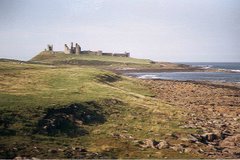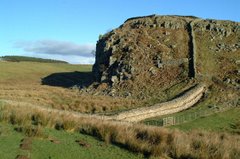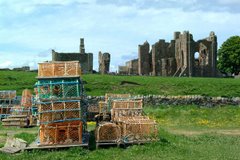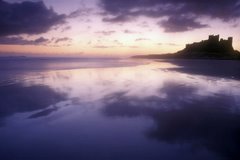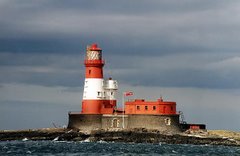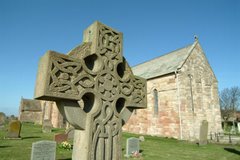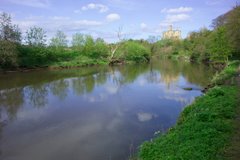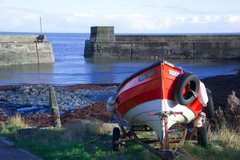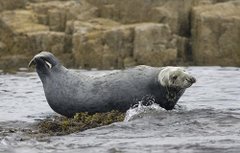Craster
Craster is a small fishing village on the Northumbrian coast of England. It has a small and attractive harbour and offers a view northwards along the rocky shore to the spectacular ruins of Dunstanburgh Castle. This is the nearest point of access to the castle and the approach must be made on foot as there is just a grassy path. The next village to the north is Embleton.
For many years, the village has had herring-curing business and Craster kippers are well known in England. The local herrings are smoked in a traditional manner by the Robson family.
The remains of a tower on the end of the harbour are all that can be seen now of the much taller building which was part of the overhead equipment which used to convey the local stone from where it was quarried to boats in the harbour. Craster Tower, as it is called, is the home of the Craster family who owned the quarry and had the harbour improved for its benefit. A memorial on the harbour wall commemorates a member of the Craster family who died serving with the British army in Tibet in the 19th century.
The walk along the coast to the south is almost as spectacular as that to the north and passes by Cullernose Point, an example of the basaltic cliffs which are a significant feature of the local landscape.
Article adapted from the Wikipedia online encyclopedia.
How to get to Craster:
By road: Take the main A1 trunk road north from Newcastle upon Tyne, to Alnwick. Take the Alnwick exit and follow the road towards Alnwick town centre. From the town centre take the B1340 towards Seahouses and the coast. Craster is about 6 miles north east of Alnwick.
By rail: The nearest station is Alnmouth.
By bus: Arriva Northumbria service 501 goes from the Haymarket Bus Station in Newcastle via Alnwick to Craster. In the reverse direction, the 501 goes from Berwick via the coast to Craster. During the summer months the Coastal Clipper service runs between Bamburgh and Amble, via Craster.
Map of area: CLICK HERE
For many years, the village has had herring-curing business and Craster kippers are well known in England. The local herrings are smoked in a traditional manner by the Robson family.
The remains of a tower on the end of the harbour are all that can be seen now of the much taller building which was part of the overhead equipment which used to convey the local stone from where it was quarried to boats in the harbour. Craster Tower, as it is called, is the home of the Craster family who owned the quarry and had the harbour improved for its benefit. A memorial on the harbour wall commemorates a member of the Craster family who died serving with the British army in Tibet in the 19th century.
The walk along the coast to the south is almost as spectacular as that to the north and passes by Cullernose Point, an example of the basaltic cliffs which are a significant feature of the local landscape.
Article adapted from the Wikipedia online encyclopedia.
How to get to Craster:
By road: Take the main A1 trunk road north from Newcastle upon Tyne, to Alnwick. Take the Alnwick exit and follow the road towards Alnwick town centre. From the town centre take the B1340 towards Seahouses and the coast. Craster is about 6 miles north east of Alnwick.
By rail: The nearest station is Alnmouth.
By bus: Arriva Northumbria service 501 goes from the Haymarket Bus Station in Newcastle via Alnwick to Craster. In the reverse direction, the 501 goes from Berwick via the coast to Craster. During the summer months the Coastal Clipper service runs between Bamburgh and Amble, via Craster.
Map of area: CLICK HERE



